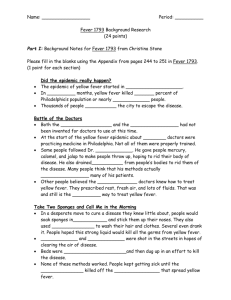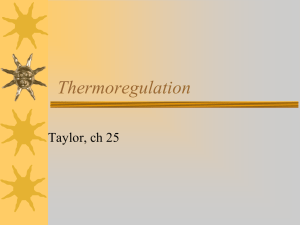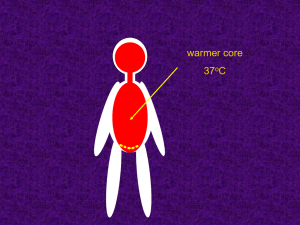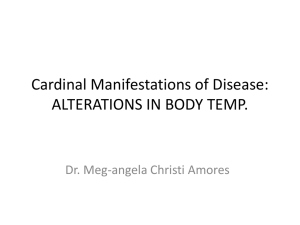Yellow fever - Garnet Valley School District
advertisement
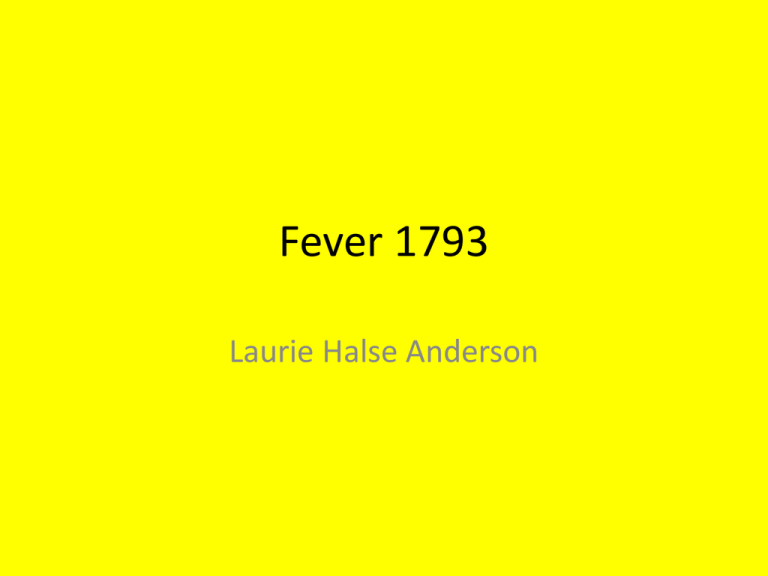
Fever 1793 Laurie Halse Anderson Yellow Fever • Yellow fever • Yellow fever is a viral infection spread by mosquitoes. • Causes, incidence, and risk factors • Yellow fever is caused by a virus carried by mosquitoes. You can catch this disease if you are bitten by a mosquito infected with this virus. • This disease is common in South America and in sub-Saharan Africa. • Anyone can get yellow fever, but the elderly have a higher risk of severe infection. • If a person is bitten by an infected mosquito, symptoms usually develop 3 - 6 days later. • In 1793 it was wrongly believed that it fever was contagious, meaning you could catch it from an infected individual. Yellow Fever • Yellow fever has three stages: • Stage 1 (infection): Headache, muscle and joint aches, fever, flushing, loss of appetite, vomiting, and jaundice are common. Symptoms often go away briefly after about 3-4 days. • Stage 2 (remission): Fever and other symptoms go away. Most people will recover at this stage, but others may get worse within 24 hours. • Stage 3 (intoxication): Problems with many organs occur. This may include heart, liver, and kidney failure, bleeding disorders, seizures, coma, and delirium. Yellow Fever • • • • • • • • • • • • Symptoms may include: Irregular heart beats(arrhythmias) Bleeding (may progress to hemorrhage) Coma Delirium Fever Headache Yellow skin and eyes (jaundice) Muscle aches Red eyes, face, tongue Seizures Vomiting, possibly vomiting blood, called Black Vomit Philadelphia 1793 • The nation’s capitol at this time • Philadelphia was one of the largest cities in the US at the time, and still is today. • However, the city is much larger today than it was then. Philadelphia ended at ninth street to the west, and Cedar(South St.)to the south, and Mulberry(Race St) to the north Philadelphia 1793 • George Washington and other prominent officials left during the epidemic. • Dr. Benjamin Rush attributed the cause of the Yellow Fever outbreak to coffee shipments rotting on the docks. Believed the Fever was contagious. • Dr. Rush met with some success in treating Yellow Fever. One of his treatments involved “bleeding” a patient and having them ingest mercury. • Both of these treatments were later discovered to be more dangerous than helpful. Philadelphia 1793 • African Americans were enlisted as volunteers to help the infected. • It was believed at the time that African American were immune to Yellow Fever. • Stephen Girard and Dr. Jean Deveze, disagreed with Dr. Rush’s treatments and came up with a different treatment. Deveze became the first leading specialist in treatment of Yellow Fever. • Deveze proved that Yellow Fever is not contagious. • Girard Avenue in Philadelphia is named after Stephen Girard for his work during the Yellow Fever epidemic. Review Questions • • • • • Answer each of the following questions on a separate piece of note book paper 1. What is Yellow Fever? 2. How is Yellow Fever spread? 3. What misinformation, about how Yellow Fever was spread, was later proven to be untrue? 4. List the three major symptoms of Yellow Fever.(hint: They are bolded and italicized.) 5. What distinction did Philadelphia have at this time? Review Questions (continued) • • • • • Answer each of the following questions on a separate piece of note book paper 6. What Famous individual left the city during the outbreak? 7. Why do you think this person left? 8. Who is Dr. Benjamin Rush and what accomplishment are attributed to him? (Write your answer in your own words.) 9. What group of individuals were asked to assist in helping the sick? 10. Why were they asked? Review Questions(continued) Answer each of the following questions on a separate piece of note book paper • 11. Which Philadelphian had a street named after him because of his actions during the outbreak? • 12 Who is Dr. Jean Deveze? • 13. List 2 important facts about him.



